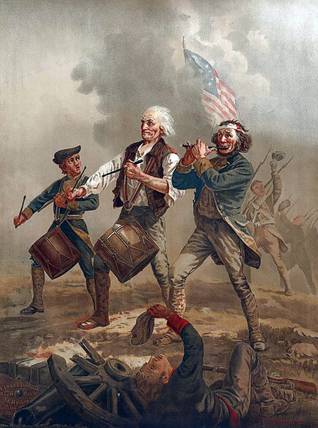
The New York Times
An undated handout photo of the painting by A. M. Willard made in the late 19th century, originally titled “Yankee Doodle,” that came to be known as “The Spirit of ’76.”
Tuesday, July 4, 2017 | 2 a.m.
David Ditta, who just retired as a commercial photographer and videographer in California, was a genealogist by avocation who could trace his American ancestors, the Davenports, back to relatives who arrived in 1637.
What Ditta, who is 67 and lives near San Francisco, didn’t know until recently was that he is also descended from the Fitch family of Norwalk, Connecticut. Thomas Fitch IV was a governor of Connecticut in the 18th century, but his son, Col. Thomas Fitch V, became even more famous as the person believed to be the inspiration for the tune “Yankee Doodle.”
With the Fourth of July approaching, researchers for MyHeritage.com, a website that enables people to explore their family histories, decided to find out whether Col. Fitch had any living descendants. The researchers discovered that Ditta is his great-great-great-great-great-grandson.
“When they first sent me a message, I figured there’s not a chance,” Ditta said. “I had a pretty good idea of our genealogy. But when I saw the connection with the Davenports, it all clicked.”
The music has been traced back centuries to England; the lyrics, in their many incarnations, are attributed to multiple sources.
One was Dr. Richard Shuckburgh, a surgeon attached to the British army in upstate New York during the French and Indian War when Fitch was said to have arrived with his Connecticut recruits.
To lend their ragtag appearance some proper uniformity, his sister supposedly supplied each recruit with a chicken feather for his hat — a costume that Shuckburgh good-naturedly mocked in a mid-1750s ditty he was said to have written while stationed at Fort Crailo across the Hudson River from Albany.
Etymologists differ on the origin of the lyrics, but Yankee typically referred to New Englanders, doodle was a term of derision and dandy was someone who affected sophistication (fashionable macaroni wigs also became a metaphor for foppishness).
The American irregulars won the respect of the Redcoats after their successes in 1759 at Fort Ticonderoga and Crown Point, and by the American Revolution the song had evolved from an aspersion to a patriotic march of pride.
Fitch supposedly lived in what became known as the Yankee Doodle House in Norwalk until it was razed early in the 20th century.
A cemetery marker in Norwalk, where he died in 1795 after serving in the state House of Representatives, credits him as the stimulus for the song, whose most popular lyrics begin:
Yankee Doodle went to town,
A-riding on a pony.
Stuck a feather in his cap,
And called it macaroni.
Ditta said he may celebrate the Fourth of July by singing the song — “that would be kind of fun,” he said. Now that he’s retired, he added, “With more spare time, I may head back East and take a better look at my roots.”

Join the Discussion:
Check this out for a full explanation of our conversion to the LiveFyre commenting system and instructions on how to sign up for an account.
Full comments policy